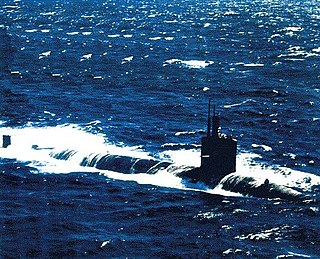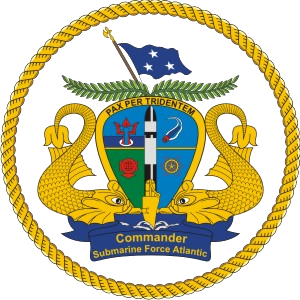
Deep Submergence Vessel NR-1 was a unique United States Navy (USN) nuclear-powered ocean engineering and research submarine, built by the Electric Boat Division of General Dynamics at Groton, Connecticut. NR-1 was launched on 25 January 1969, completed initial sea trials 19 August 1969, and was home-ported at Naval Submarine Base New London. NR-1 was the smallest nuclear submarine ever put into operation. The vessel was casually known as "Nerwin" and was never officially named or commissioned. The U.S. Navy is allocated a specific number of warships by the U.S. Congress, but Admiral Hyman Rickover avoided using one of those allocations for the construction of NR-1 in order to circumvent the oversight that a warship receives from various bureaus.

USS Thresher (SSN-593) was the lead boat of her class of nuclear-powered attack submarines in the United States Navy. She was the U.S. Navy's second submarine to be named after the thresher shark.

USS La Jolla (SSN-701/MTS-701), a Los Angeles-class submarine, is named for La Jolla, California. The contract to build her was awarded to the Electric Boat Division of General Dynamics Corporation in Groton, Connecticut on 10 December 1973 and her keel was laid down on 16 October 1976. She was launched on 11 August 1979 sponsored by Mrs. Jean Bryant Wilson, wife of Congressman Bob Wilson, and commissioned on 24 October 1981. In 2017, La Jolla was converted to a Moored Training Ship and is currently stationed at NPTU Charleston in Goose Creek, SC.

USS Nautilus (SSN-571) was the world's first operational nuclear-powered submarine and the first submarine to complete a submerged transit of the North Pole on 3 August 1958. Her initial commanding officer was Eugene "Dennis" Wilkinson, a widely respected naval officer who set the stage for many of the protocols of today's Nuclear Navy of the US, and who had a storied career during military service and afterwards.

USS Pogy (SSN-647), a Sturgeon-class submarine, was the second ship of the United States Navy to be named for the pogy, or menhaden.

USS Louisville (SSN-724), a Los Angeles-class submarine, is the fourth ship of the United States Navy to be named for Louisville, Kentucky. The contract to build her was awarded to the Electric Boat Division of General Dynamics Corporation in Groton, Connecticut, on 11 February 1982 and her keel was laid on 24 September 1984. She was launched on 14 December 1985—sponsored by Mrs. Betty Ann McKee, wife of Admiral Kinnaird McKee, Director of Naval Nuclear Propulsion —and commissioned on 8 November 1986 with Captain Charles E. Ellis in command.
A nuclear navy, or nuclear-powered navy, refers to the portion of a navy consisting of naval ships powered by nuclear marine propulsion. The concept was revolutionary for naval warfare when first proposed. Prior to nuclear power, submarines were powered by diesel engines and could only submerge through the use of batteries. In order for these submarines to run their diesel engines and charge their batteries they would have to surface or snorkel. The use of nuclear power allowed these submarines to become true submersibles and unlike their conventional counterparts, they became limited only by crew endurance and supplies.

USS Pargo (SSN-650), a Sturgeon-class attack submarine, was the second ship of the United States Navy to be named for the pargo, also known as the red snapper, a fish of the genus Lutjanus found in the West Indies.

USS Cavalla (SSN-684), a Sturgeon-class submarine, was the second ship of the United States Navy to be named for the cavalla, a salt water fish. Although it was a Sturgeon class design, Cavalla was a modified "long hull" boat, approximately 10 feet (3.0 m) longer than the earlier ships in its class.

USS Batfish (SSN-681), was a nuclear-powered attack submarine of the United States Navy. She was the eleventh Sturgeon-class submarine launched. Her primary missions were anti-submarine warfare, intelligence gathering, and screening carrier battle groups. She was launched in 1971 and decommissioned in 1999.
One ship of the United States Navy and one planned one have been named USS Hyman G. Rickover, after Admiral Hyman G. Rickover, known as the "Father of the Nuclear Navy".

Commander, Submarine Force Atlantic (COMSUBLANT) is the Submarine Force U.S. Atlantic Fleet type commander under the United States Fleet Forces Command.

Kinnaird Rowe McKee was an American United States Navy four star admiral who served as Director, Naval Nuclear Propulsion from 1982 to 1988. He also served as Superintendent, United States Naval Academy from 1975 to 1978.

Steven Angelo White was a four-star admiral who served in the United States Navy from 1948 until 1985. He was the 19th and last Chief of Naval Material.
Hyman G. Rickover (1900–1986) was a U.S. naval admiral responsible for the development of naval nuclear propulsion, and also known as the "Father of the Nuclear Navy"
Operation Sunshine was a scientific expedition conducted by the United States Navy in the summer of 1958. A crew of just over 100 sailors piloted USS Nautilus (SSN-571) under the North Pole. Nautilus was chosen for the mission because her nuclear reactor allowed her to remain submerged longer than a conventional submarine. The mission was completed successfully on August 3, 1958, when Nautilus and crew crossed under the North Pole.

Oregon is a nuclear powered attack submarine in the United States Navy. She is the fourth vessel to carry the name Oregon, the 33rd state of US, and the 20th Virginia-class submarine. Secretary of the Navy Ray Mabus announced her name on 10 October 2014 at a ceremony hosted at the Battleship Oregon Memorial in Tom McCall Waterfront Park in Portland, Oregon.

USS Hyman G. Rickover (SSN-795), is a Virginia-class nuclear-powered attack submarine of the United States Navy and the second such boat commemorating Admiral Hyman G. Rickover, pioneer of the nuclear navy. The boat's sponsor is Darleen Greenert, wife of then Chief of Naval Operations, Admiral Jonathan Greenert. Both the boat's name and her sponsor were announced by the Secretary of the Navy at a ceremony at the Washington Navy Yard on 9 January 2015. Hyman G. Rickover's christening occurred on 31 July 2021.

Captain John Henry Ebersole, M.D., MC USN was a pioneer in submarine medicine and radiation oncology, selected by Admiral Hyman G. Rickover to serve as medical officer aboard the US Navy's first two nuclear powered submarines, the USS Nautilus and the USS Seawolf. He was the radiologist for NASA that screened the Mercury Seven astronauts for Project Mercury. Ebersole was the radiologist responsible for the x-rays taken during the autopsy of John F. Kennedy on 22 November 1963 at Bethesda Naval Medical Center.

USS Resolute (AFDM-10),, was a AFDM-3-class floating dry dock built in 1945 and operated by the United States Navy.

















